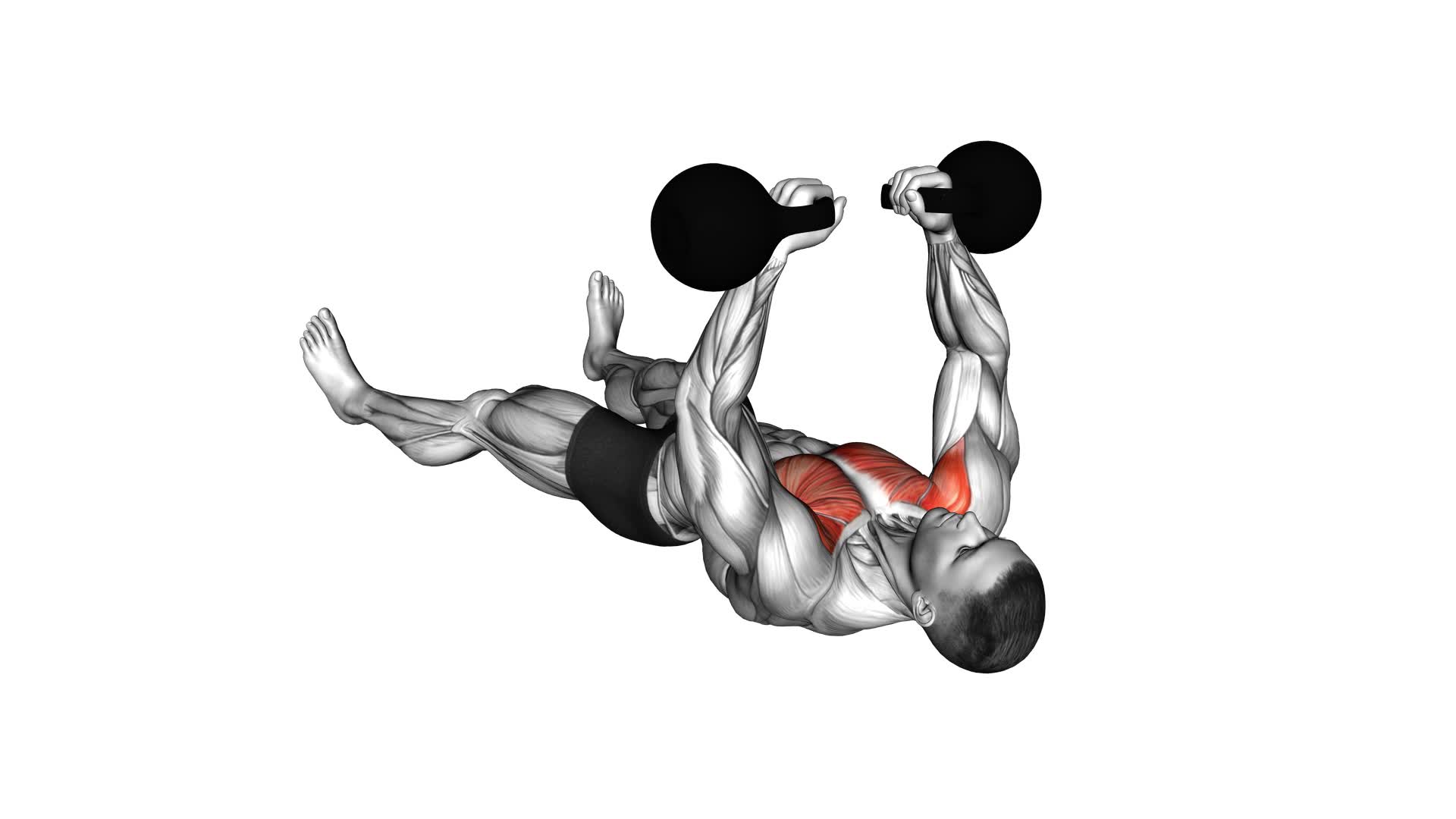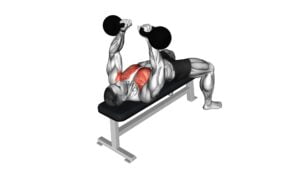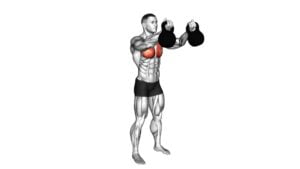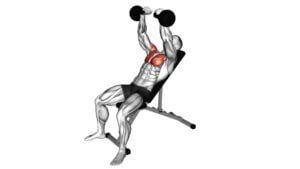Kettlebell Floor Fly – Video Exercise Guide & Tips

Are you looking for a challenging exercise that targets multiple muscle groups? Look no further than the Kettlebell Floor Fly.
Watch This Exercise Video
In this video exercise guide, we'll show you the proper form and technique to perform this effective move. With just a kettlebell and a mat, you can engage your chest, shoulders, and core.
Say goodbye to boring workouts and hello to a stronger, more sculpted body. Let's dive in and get started!
Key Takeaways
- Kettlebell Floor Fly activates multiple muscle groups simultaneously.
- It builds upper body strength and definition.
- It engages core muscles for stability and balance.
- It improves cardiovascular endurance.
Benefits of Kettlebell Floor Fly
You can experience numerous benefits from incorporating the Kettlebell Floor Fly into your workout routine. This exercise not only helps to strengthen and tone your muscles but also offers several health benefits.
One of the main advantages of the Kettlebell Floor Fly is its ability to activate multiple muscle groups simultaneously. When performing this exercise, you engage your chest, shoulders, and triceps, which helps to build upper body strength and definition. Additionally, the Kettlebell Floor Fly also engages your core muscles, promoting stability and improving your overall balance.
In terms of health benefits, the Kettlebell Floor Fly can help to improve your cardiovascular endurance. This exercise elevates your heart rate, making it an effective way to burn calories and improve your overall fitness level. Regularly incorporating the Kettlebell Floor Fly into your workout routine can also enhance your flexibility and range of motion. By stretching and extending your muscles throughout the exercise, you can improve your joint mobility and prevent injuries.
Equipment Needed for Kettlebell Floor Fly
To perform the Kettlebell Floor Fly, you'll need a kettlebell and a mat. These two pieces of equipment are essential for executing the exercise safely and effectively. The kettlebell is the main tool used in kettlebell exercises, and it plays a crucial role in the Kettlebell Floor Fly. It's recommended to choose a weight that challenges you but still allows you to maintain proper form throughout the movement.
A mat is necessary to provide cushioning and support for your body while performing the exercise on the floor. It helps protect your back and provides stability during the movement.
While a kettlebell and a mat are the primary equipment needed for the Kettlebell Floor Fly, there are alternative equipment options available. If you don't have access to a kettlebell, you can use a dumbbell or a resistance band as a substitute. However, it's important to note that the grip and movement patterns may vary slightly with alternative equipment. Therefore, it's advisable to seek guidance from a fitness professional to ensure proper form and technique when using alternative equipment for kettlebell exercises.
Proper Form and Technique for Kettlebell Floor Fly
To execute the Kettlebell Floor Fly with proper form and technique, maintain a stable core and engage your chest muscles throughout the movement. Begin by lying on your back with your knees bent and feet flat on the floor. Hold a kettlebell in each hand, with your arms extended straight up towards the ceiling. Slowly lower the kettlebells towards the ground, keeping your elbows slightly bent. As you lower the kettlebells, focus on squeezing your chest muscles and maintaining control. Make sure to keep your core engaged and avoid arching your back.
Common mistakes to avoid include using momentum to lift the kettlebells, allowing your back to lift off the floor, or letting the kettlebells touch the ground. These mistakes can lead to improper form and reduce the effectiveness of the exercise.
Remember, proper technique is crucial to get the most out of the Kettlebell Floor Fly. By maintaining a stable core and engaging your chest muscles throughout the movement, you'll effectively target and strengthen your chest.
Transitioning into the next section, modifications and progressions for the kettlebell floor fly can help you challenge yourself and continue to progress in your fitness journey.
Modifications and Progressions for Kettlebell Floor Fly
Now, let's explore some modifications and progressions for the kettlebell floor fly exercise.
If you're a beginner, there are scaling options available to make the exercise more manageable for you.
On the other hand, if you're more advanced, there are variations that can challenge you even further.
It's important to find the right level of difficulty that suits your fitness level and allows for progression over time.
Scaling Options for Beginners
When starting out with the Kettlebell Floor Fly, you can modify and progress the exercise to suit your fitness level. Here are three scaling options for beginners:
- Start with a lighter kettlebell: If you're new to kettlebell training, it's important to choose a weight that allows you to maintain proper form throughout the exercise. Begin with a lighter kettlebell and gradually increase the weight as you get stronger.
- Perform the exercise without weights: If you're not comfortable using kettlebells yet, you can still benefit from the Floor Fly by performing it without any weights. Focus on perfecting your technique and gradually add weights as you become more confident.
- Reduce the range of motion: If you find it challenging to fully extend your arms during the exercise, you can reduce the range of motion by only lowering the kettlebells halfway to the floor. As you build strength and flexibility, gradually increase the range of motion.
Advanced Variations for Experts
You can challenge yourself with advanced variations of the Kettlebell Floor Fly to further enhance your strength and coordination. These advanced techniques will push your limits and take your workout to the next level.
One advanced variation is the Single-Arm Kettlebell Floor Fly, where you perform the exercise with only one arm at a time, increasing the demand on your core and stability.
Another option is the Bottoms-Up Kettlebell Floor Fly, where you hold the kettlebell upside down, forcing you to engage your grip strength and forearm muscles.
Finally, the Kettlebell Floor Press Fly Combo combines the floor fly with a floor press, providing a challenging full-body workout.
These advanced variations will keep you engaged and continuously improving. Now, let's move on to the next section to learn about common mistakes to avoid during the kettlebell floor fly.
Common Mistakes to Avoid During Kettlebell Floor Fly
To optimize your performance during the Kettlebell Floor Fly, make sure to steer clear of these common mistakes:
- Improper Form: One of the most common mistakes people make during the Kettlebell Floor Fly is using improper form. It's important to maintain a neutral spine throughout the exercise and avoid arching your back or rounding your shoulders. This will help to target the muscles effectively and prevent any strain or injury.
- Gripping Too Tightly: Another mistake to avoid is gripping the kettlebell too tightly. While it's important to have a secure grip, gripping too tightly can lead to unnecessary tension in your forearms and wrists. Instead, focus on maintaining a firm but relaxed grip to allow for smoother movement and better control.
- Neglecting Control and Range of Motion: Many people rush through the Kettlebell Floor Fly without paying attention to control and range of motion. It's important to perform the exercise in a slow and controlled manner, focusing on the muscles being targeted. Additionally, make sure to fully extend your arms at the top of the movement and lower the kettlebell back down with control, without bouncing it off the floor.
By avoiding these common mistakes and focusing on proper technique, you can maximize the benefits of the Kettlebell Floor Fly.
Now, let's move on to the next section: tips for incorporating kettlebell floor fly into your workout routine.
Tips for Incorporating Kettlebell Floor Fly Into Your Workout Routine
To effectively incorporate the Kettlebell Floor Fly into your workout routine, focus on gradually increasing the weight and repetitions for continued progress. This exercise is a great way to target your chest muscles and build upper body strength.
When incorporating kettlebells into your floor exercises, it's important to start with a weight that challenges you but still allows you to maintain proper form. As you become more comfortable with the movement, slowly increase the weight to continue challenging your muscles.
In addition to increasing the weight, you can also vary the number of repetitions you perform. Start with a lower number of reps, such as 8-10, and gradually work your way up to 12-15 or more. This will help prevent plateaus and keep your muscles constantly adapting and growing.
Another tip for incorporating the Kettlebell Floor Fly into your workout routine is to ensure that you're using proper form throughout the exercise. Keep your back flat against the floor and engage your core to stabilize your body. Focus on a slow and controlled movement, keeping your elbows slightly bent and your wrists aligned with your shoulders.
Frequently Asked Questions
How Heavy Should the Kettlebell Be for Performing the Floor Fly Exercise?
For the floor fly exercise with kettlebells, it's crucial to choose an appropriate weight. You need a kettlebell that challenges your muscles but allows you to maintain proper form and technique.
Start with a lighter weight and gradually increase as you build strength and confidence. Remember, the focus should be on maintaining control and stability throughout the movement.
Consult with a fitness professional to determine the ideal weight for your fitness level and goals.
Can the Kettlebell Floor Fly Exercise Be Performed Without a Kettlebell?
If you don't have a kettlebell, you can still perform the kettlebell floor fly exercise using your bodyweight. This exercise targets your chest, shoulders, and triceps, helping to strengthen and tone those areas.
Bodyweight alternatives can be just as effective in building strength and muscle. However, using a kettlebell adds extra resistance and challenges your muscles even more.
How Many Repetitions and Sets Should I Do for the Kettlebell Floor Fly Exercise?
To determine how many repetitions and sets you should do for the kettlebell floor fly exercise, consider your fitness goals and current level of strength. It's generally recommended to start with 3-4 sets of 8-12 repetitions.
As you progress, you can increase the number of sets or repetitions. There are also variations of the kettlebell floor fly exercise that you can incorporate to add variety and challenge to your workout routine.
Is the Kettlebell Floor Fly Exercise Suitable for Beginners?
The kettlebell floor fly exercise can be suitable for beginners with proper form and technique. It targets the chest, shoulders, and triceps. To perform it correctly, lie on your back with knees bent, holding the kettlebells directly above your chest.
Lower the weights out to the sides, keeping a slight bend in your elbows. For beginners, start with lighter weights and focus on mastering the movement before progressing.
Always consult a professional trainer for modifications and progressions.
Can the Kettlebell Floor Fly Exercise Help in Strengthening the Core Muscles?
Incorporating kettlebell exercises into your workout routine has numerous benefits, including strengthening your core muscles.
One effective exercise for this is the kettlebell floor fly. By properly executing this exercise, you can maximize its effectiveness in targeting and strengthening your core.
Remember to maintain proper form and control throughout the movement to ensure optimal results.
Consistently incorporating this exercise into your routine can help you achieve a stronger and more stable core.
Conclusion
Incorporating the kettlebell floor fly into your workout routine can provide numerous benefits. This exercise targets the chest, shoulders, and triceps while also engaging the core and promoting stability.
By following proper form and technique, you can maximize the effectiveness of this exercise and prevent common mistakes.
With the right modifications and progressions, you can tailor the kettlebell floor fly to your fitness level.
So grab your kettlebell and start reaping the rewards of this challenging yet rewarding exercise.

Author
Years ago, the spark of my life’s passion ignited in my mind the moment I stepped into the local gym for the first time. The inaugural bead of perspiration, the initial endeavor, the very first surge of endorphins, and a sense of pride that washed over me post-workout marked the beginning of my deep-seated interest in strength sports, fitness, and sports nutrition. This very curiosity blossomed rapidly into a profound fascination, propelling me to earn a Master’s degree in Physical Education from the Academy of Physical Education in Krakow, followed by a Sports Manager diploma from the Jagiellonian University. My journey of growth led me to gain more specialized qualifications, such as being a certified personal trainer with a focus on sports dietetics, a lifeguard, and an instructor for wellness and corrective gymnastics. Theoretical knowledge paired seamlessly with practical experience, reinforcing my belief that the transformation of individuals under my guidance was also a reflection of my personal growth. This belief holds true even today. Each day, I strive to push the boundaries and explore new realms. These realms gently elevate me to greater heights. The unique combination of passion for my field and the continuous quest for growth fuels my drive to break new ground.



